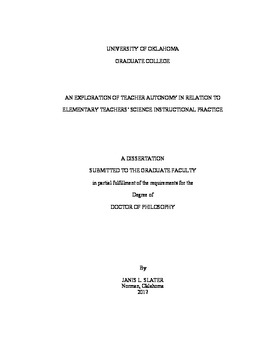| dc.description.abstract | This mixed methods study uses a participant selection model with a qualitative emphasis (Creswell & Plano-Clark, 2007) to examine the science teaching practices of elementary teachers in self-contained classrooms. Their choices regarding amount of time and teaching methodology are explored in relation to their perceptions of instructional and curricular autonomy within their teaching context. The study focuses on reform teaching methods such as those outlined in A Framework for K-12 Science Education (NRC, 2011) as the desired standard of practice for science instruction. The Framework emphasizes the importance of the role of elementary science education in providing a foundation for scientific literacy and proficiency, which has also been incorporated into the recently released Next Generation Science Standards (2013). Even with this national imperative, statistics show that significantly less time is spent in elementary schools on science instruction than on other core subjects (Banilower et al., 2013). It has become imperative to find ways to support and encourage teachers to devote sufficient time to science teaching and learning.
Studies in science education examining the relationship between teacher beliefs about science and science learning and what they do in their classroom have yielded mixed results. Teacher efficacy and nature of science beliefs are not consistently shown to match elementary teachers’ enacted classroom practice (Jones & Leagon, 2014). These discrepancies show that the belief constructs behind teachers’ instructional decisions, rather than being linear and predictable, are complex, interrelated, and situated in context. This has made it difficult to delineate specific ways to help teachers implement reform-based science teaching practices (Davis, Petish, & Smithey, 2006; Russell & Martin, 2014).
Another approach to studying the disconnect between beliefs and practice could be to explore teacher motivation for science instruction through a motivational framework that considers context within the belief system. This study frames the issue from a motivational approach using Self-determination Theory (Ryan & Deci, 2000). Self-determination Theory (SDT) is concerned with looking at the decisions people make based on the perception that their psychological needs for autonomy, competence, and relatedness have been met. The study examines teacher perceptions of autonomy in relation to their instructional choices about science teaching.
Findings show that contextual factors considered through the needs-based perspective of SDT can either support or serve as barriers to teacher autonomy for acting on beliefs they have formed through teacher education and experience. Identification of autonomy support structures has the potential to inform professional development and teacher education to find ways to encourage elementary science instruction at a time when its importance has been elevated by the Framework and the NGSS. | en_US |
